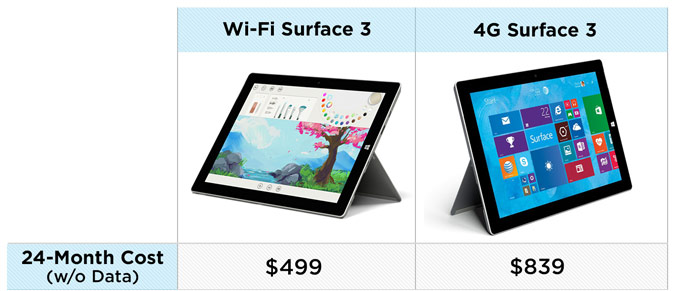Why 4G Tablets Are a Total Rip-Off
If you're the kind of person who would page Uber to drive you across the street or buy an episode of Orange is the New Black on Google Play, even though you already have Netflix, a 4G LTE tablet should be your next major purchase. Not content to drain your bank account with smartphone charges alone, the four major carriers would like you to spend hundreds of dollars more to get mobile Internet service on a slate.
Yes, having a cellular connection on your iPad, Android or Surface is a helpful convenience, but when you look at the numbers and realize you can get the same connection for free, all the carrier marketing just falls flat.
A High Premium for Convenience
Before you even use one kilobyte of data, a 4G tablet will usually cost you over $300 more than its Wi-Fi–only equivalent over a 24-month period. The hardware itself usually carries a $100 to $150 premium, just for including a 4G LTE radio. Then, the carrier usually requires a $10 to $15 monthly access fee in addition to the data cost.
This week, AT&T proudly announced that it will be the first carrier to sell a 4G version of Microsoft's Surface 3 tablet. Unless you get a special discount for buying a Lumia phone, the 4G Surface 3 costs $600, spread out over a period of 20 months. Adding the tablet to your Mobile Share plan costs $10 per month, on top of the fees you already pay for data and connecting your smartphone. If you don't have a share plan, expect to pay a minimum of $15 per month (for just 250MB).
A similarly configured Wi-Fi Surface 3 costs $499. So, over the course of two years, you're paying $340 to get the device online and sharing from the same pool of data that you're already buying for your phone.
AT&T is hardly alone in gouging customers for tablets and their access fees. Verizon also charges $10 per month to add your tablet to a "More Everything" plan or $30 per month for a tablet-only plan. Sprint charges $480 over 24 months just to lease a 64-GB iPad Air 2 (or $529 to buy on-contract) as part of the company's iPad for Life plan, along with a $10 monthly access fee to add the tablet to your More Everything plan. The hardware price, if you buy it on-contract, is actually a little less than the price of a Wi-Fi 64GB model ($599 from Apple), but you more than make up for it in access fees and presumably increased data usage. T-Mobile charges full price, $729, for a 64GB iPad Air 2 and requires a separate data plan that costs a minimum of $20 per month.
Connect Your Tablet to 4G for Free
Fortunately, you can get any Wi-Fi tablet connected for free if you just use your smartphone's hot-spot feature. Most smartphones come with hot-spot capability built in, or, if you're on Android and don't have it, you can install FoxFi, an $8 app that gives you this capability. By tethering your tablet to a hot spot, you'll still be using up data from your bucket, but you won't pay any additional access fees or pony up an extra $100 on the cost of the tablet.
Sign up to receive The Snapshot, a free special dispatch from Laptop Mag, in your inbox.
To be fair, having 4G built into your tablet has a couple of small advantages over tethering it to your phone. You don't need to worry about running down your smartphone's battery by using it as a hot spot, and you can even leave the handset behind. However, you probably don't leave home without your smartphone, and, if battery life is a concern, you can always spend a few dollars on a portable charger or battery case. Having 4G on your tablet offers a small amount of convenience, but unless you're spending someone else's money, it's not worth the $300+ premium.
- Best 2-in-1s (Laptop/Tablet Hybrids)
- 10 Tablets with the Longest Battery Life
- Our Favorite Tablets for Work and Play
Tablet Guide
- Kids Tablets to Buy (or Avoid)
- 10 Tablets with the Longest Battery Life
- Tablet Buying Guide: 8 Essential Tips
- The Best Tablets for Less Than $200
- Chromebook vs. Tablet: Which Should You Buy?
- How to Sell, Trade In or Donate Your Old Tablet
- iPad Buying Guide: Which One is Right for You?
- How to Use Your iPad as Your Only PC


